1996 PONTIAC BONNEVILLE check engine
[x] Cancel search: check enginePage 124 of 387
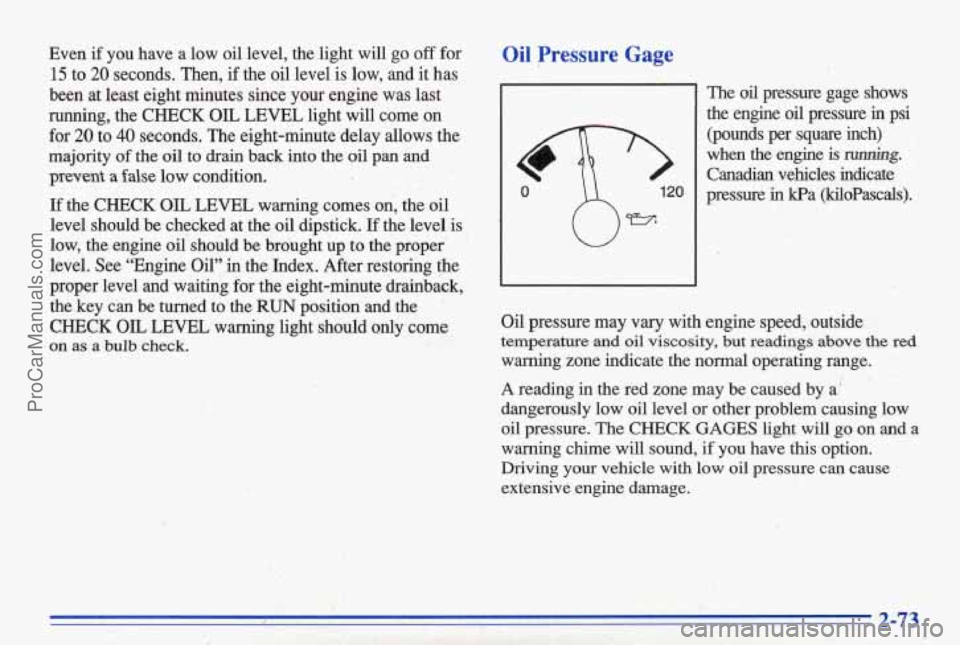
Even if you have a low oil level, the light will go off for
15 to 20 seconds. Then, if the oil level is low, and it has
been at least eight minutes
since your engine was last
running, the
CHECK OIL LEVEL light will come on
for
20 to 40 seconds. The eight-minute delay allows the
majority of the oil to drain back into the oil pan and
prevent a false low condition.
If the CHECK OIL LEVEL warning comes on, the oil
level should be checked at the oil dipstick. If the level is
low, the engine
oil should be brought up to the proper
level. See “Engine Oil” in the Index. After restoring the\
proper level and waiting for the eight-minute drainback,
the key can be turned to the
RUN position and the
CHECK OIL LEVEL warning light should only come
on as a bulb check.
Oil Pressure Gage
The oil pressure gage shows
the engine
oil pressure in psi
(pounds per square inch)
when
the engine is rwmhg.
Canadian vehicles indicate
pressure in kPa (kiloPascals).
Oil pressure may vary with engine speed, outside
temperature and oil viscosity, but readings above the red
warning zone indicate the normal operating range.
A reading in the red zone may be caused by a,’
dangerously low
oil level or other problem causing low
oil pressure.
The CHECK GAGES light will go on and. a
warning ch@e
will sound, if you have this option.
Driving your
vehicle with low oil pressure can cause
extensive ,engine, damage.
ProCarManuals.com
Page 125 of 387
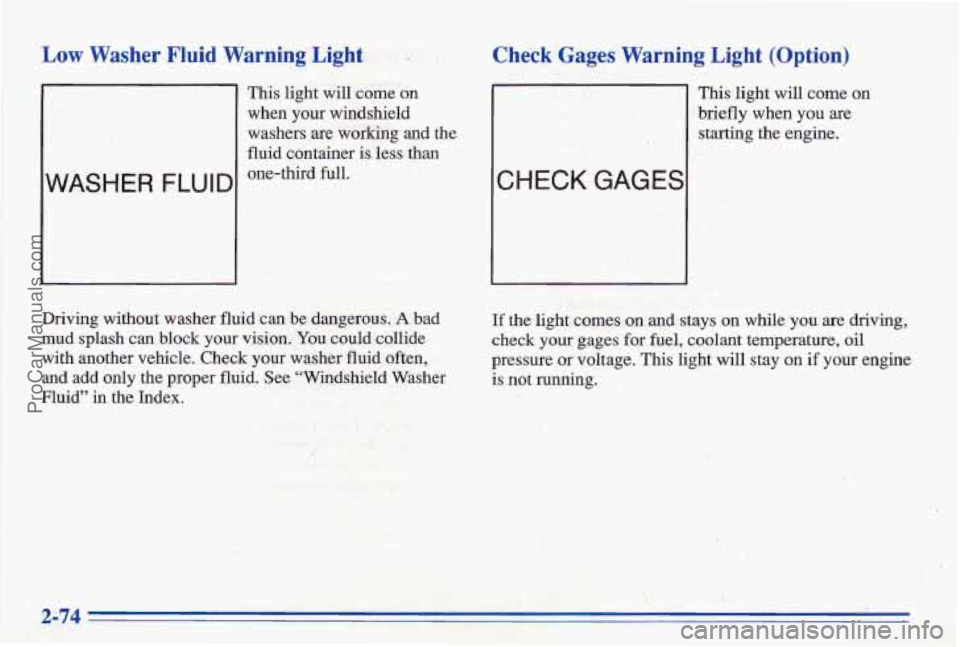
Low Washer Fluid Warning Light
WASHER FLUID
This light will come on
when your windshield
washers are working 'and the
fluid container is less
than
one-third full.
Check Gages Warning ,, Light (Option)
CHECK GAG.ES
This light will come on
briefly when you are
starting the engine.
Driving without washer fluid canbe dangerous.
A bad
mud splash can block
your vision. You could collide
with another vehicle. Check your washer
fluid often,
and add only the proper fluid. See "Windshield Washer
Fluid" in
the Index.
If the light comes on and stays on while you are driving,
check your gages for fuel, coolant temperature, okl
pressure or voltage. This light will stay on if your engine
is not running.
... . - ._
ProCarManuals.com
Page 126 of 387
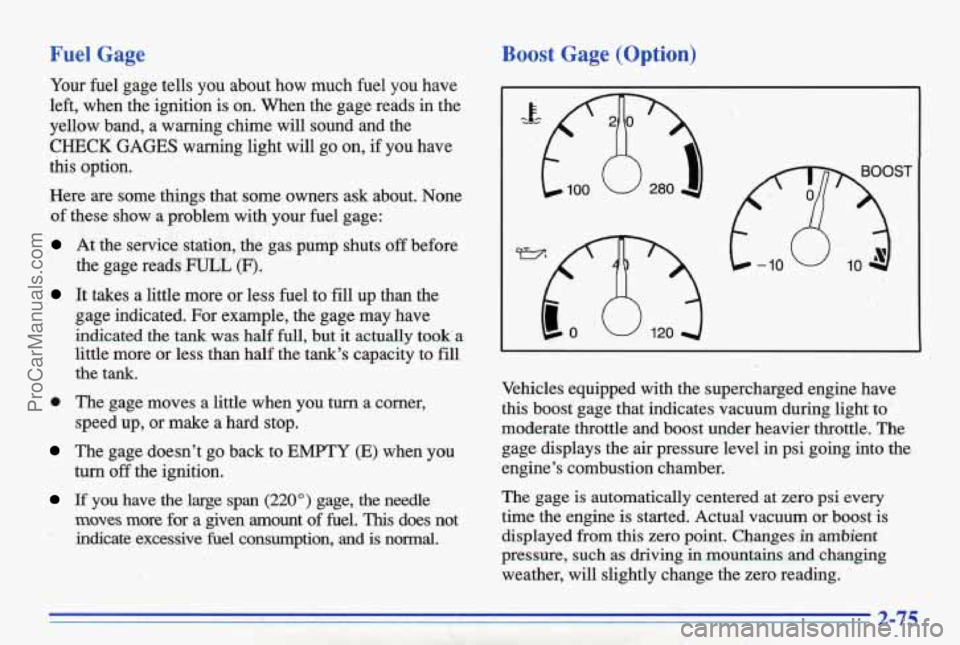
Fuel Gage
Your fuel gage tells you about how much fuel you have
left, when the ignition is on. When the gage reads in the
yellow band, a warning chime will sound and the
CHECK GAGES warning light will go on, if you have
this option.
Here
are some things that some owners ask about. None
of these show a problem with your fuel gage:
At the service station, the gas pump shuts off before
It takes a little more or less fuel to fill up than the
the
gage reads
FULL (F).
gage indicated. For example, the gage may have
indicated the tank was half full, but it actually took a
little more or less than half the tank's capacity to fill
the tank.
0 The gage moves a little when you turn a corner,
The gage doesn't go back to EMPTY (E) when you
If you have the large span (220") gage, the needle
speed up, or make a hard stop.
turn off the ignition.
moves more
for a given amount of fuel. This does not
indicate excessive
fuel consumption, and is normal.
Boost Gage (Option)
OST
Vehicles equipped with the supercharged engine have
this boost gage that indicates vacuum during light to.
moderate throttle and boost under heavier throttle. The
gage displays the air pressure level in psi going into the
engine's combustion chamber.
The gage
is automatically centered at zero psi every
time the engine is started. Actual vacuum or boost is
displayed from this zero point. Changes
in ambient
pressure, such as driving in mountains and changing
weather, will slightly change the zero reading.
ProCarManuals.com
Page 130 of 387
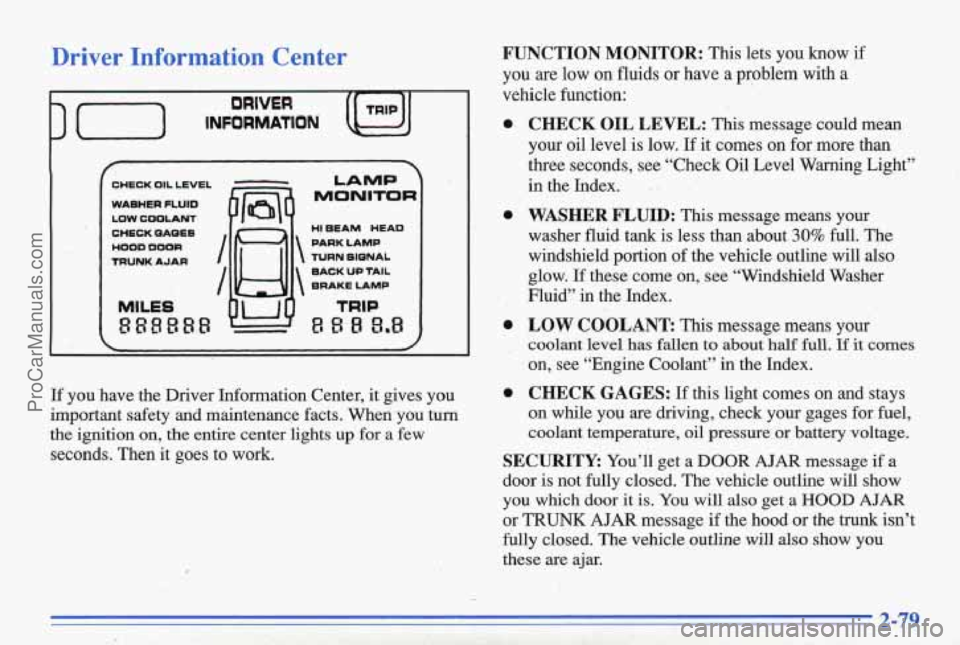
Driver Information Center
3 (-1 INFORMATION (I , J,
DRIVER TRIP
CHECK OIL LEVEL
WASHER FLUID
LOW COOLANT
CHECK QAOES
VOOD DOOR
TRUNK AJAR I
I
MlLES
888888
LAMP
MONITOR
TURN SIQNAL
BACK UP TAIL
BRAKE LAMP
TRIP
8 B 8 8.8
If you have the Driver Information Center, it gives you
important safety and maintenanc,e facts. When you turn
the ignition on, the entire center lights
up for a few
seconds. Then it goes to work.
. ..
..
.. -*
FUNCTION MONITOR: This lets you know if
you are low on fluids or have a problem with a
vehicle function:
CHECK OIL LEVEL: This message could mean
your oil level is low.
If it comes on for more than
three seconds, see "Check Oil Level
Warning Light" . ..
in the Index. - I
WASHER FLUID: This message means your
washer fluid tank is less than about
30% full. 'The
windshield portion of the vehicle outline
will also
glow.
If these come on, see "Windshield Washer
Fluid"
in the Index.
LOW COOLANT This message means your
coolant level has fallen to about half
full. If it comes
on, see "Engine Coolant" in the Index.
CHECK GAGES: If this light comes on and stays
on while you are driving, check your gages for fuel,
coolant temperature, oil pressure or battery voltage.
~. h I_ - I e:. ..
SECURITY: You'll get a DOOR AJAR message if a
door is not fully closed. The vehicle outline will show
you which door it is. You
will also get a HOOD AJAR
or TRUNK AJAR message if the hood or the trunk isn't
fully closed. The vehicle outline will
also show you
these are
ajar. ;,. . . ,--. . ,(/,,:-I.. - : , , .. , .. . . . .! _.
ProCarManuals.com
Page 163 of 387
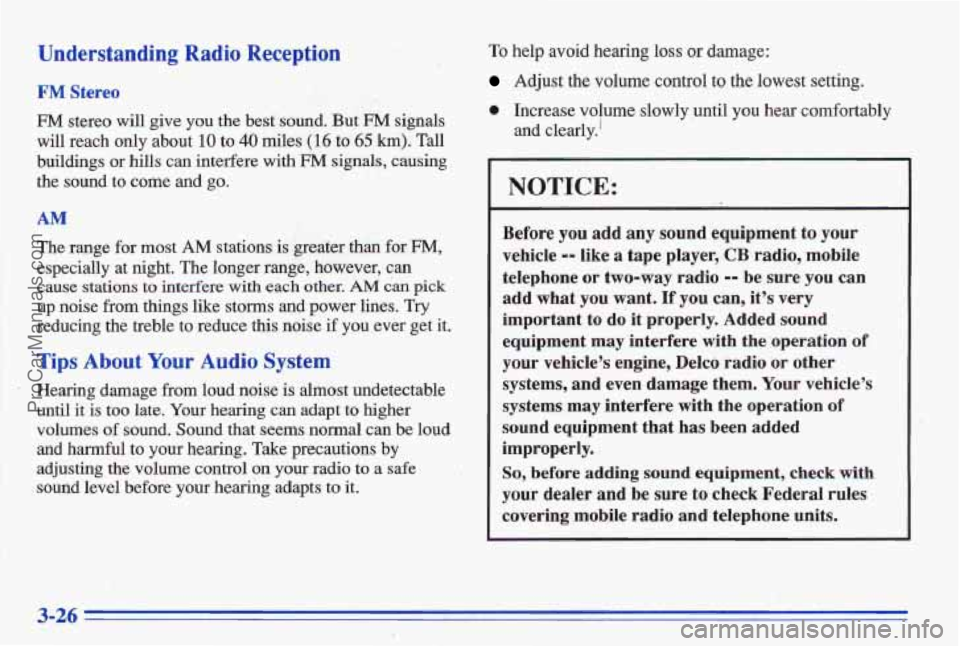
Understanding Radio eception
FM Stereo
FM stereo will give you the best sound. But EM signals
will reach only about 10 to 40 miles (16 to 65 km). Tall
buildings 'or hills can interfere with FM signals, causing
the sound to come
and go.
AM
The range for most AM stations is greater than for FM,
especially at night. The longer range, however, can
cause stations to interfere with each other. AM can pick
up noise
fkom things like storms and power lines. Try
reducing the treble to reduce this nois'e if you ever get it.
Tips About Your Audio System
I Hearing damage from loud noise is almost undetectable
until
it is too late. Your hearing can adapt to higher
volumes of sound. Sound that seems normal can be loud
and harmful to your hearing. Take precautions by
adjusting the volume control
on your radio to a safe
sound level before your hearing adapts to it.
..
1.::. .. .
. I..
1 "-
To help avoid hearing loss or damage:
Adjust the volume control to the lowest setting.
0 Increase volume slowly until you hear comfortably
and clearly.'
NOTICE:
Before you add any sound equipment to your
vehicle
-- like a tape player, CB'radio, mobile
telephone or two-way radio
-- be sure you can
add what
you want. If you can, it's very
important to
io it properly. Added sound
equipment may interfere with
the operation of
your vehicle's engine, Delco radio or other
systems,
and even damage them. Your vehicle's
systems
may interfere with the operation of
sound equipment that has been added
improperly.
So, before adding sound equipment, check with
your dealer and be sure to check Federal rules
covering mobile radio and telephone
units.
ProCarManuals.com
Page 173 of 387
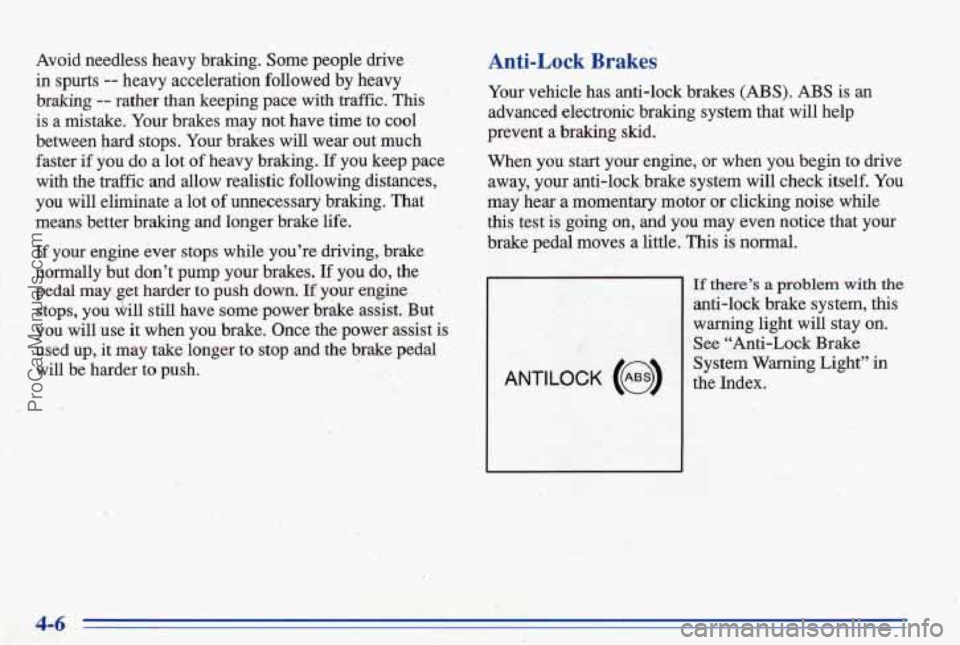
Avoid needless heavy braking. Some people drive
in spurts -- heavy acceleration followed by heavy
braking
-- rather than keeping pace with traffic. This
is a mistake. Your brakes may not have time to cool
between
hard stops. Your brakes will wear out much
faster if you
do a lot of heavy braking. If you keep pace
with the traffic and allow realistic following distances,
you will eliminate
a lot of unnecessary braking. That
means better braking
and longer brake life.
If your engine ever stops while you’re driving, brake
normally but don’t pump your brakes. If you do, the
pedal may
get harder to push down. If your engine -
stops, you dill still have some power brake assist. But
you
will use it when you brake. Once the power assist is
used up,
it may take longer to stop and the brake pedal
will be harder tol push.
Anti-Lock Brakes
Your vehicle has anti-lock brakes (ABS). ABS is an
advanced electronic braking system that will help
prevent
a braking skid.
When you start your engine, or when you begin to drive
away, your anti-lock, brake system
will check itself. You
may hear a momentary motor or clicking noise while
this test is
going on, and you may even notice that your
brake pedal moves
a little. This is normal.
ANTILOCK (a)
If there’s a problem with the
anti-lock brake system, this
warning light will stay on.
See “Anti-Lock Brake
System
Warning Light” in
the Index.
4-6
ProCarManuals.com
Page 189 of 387
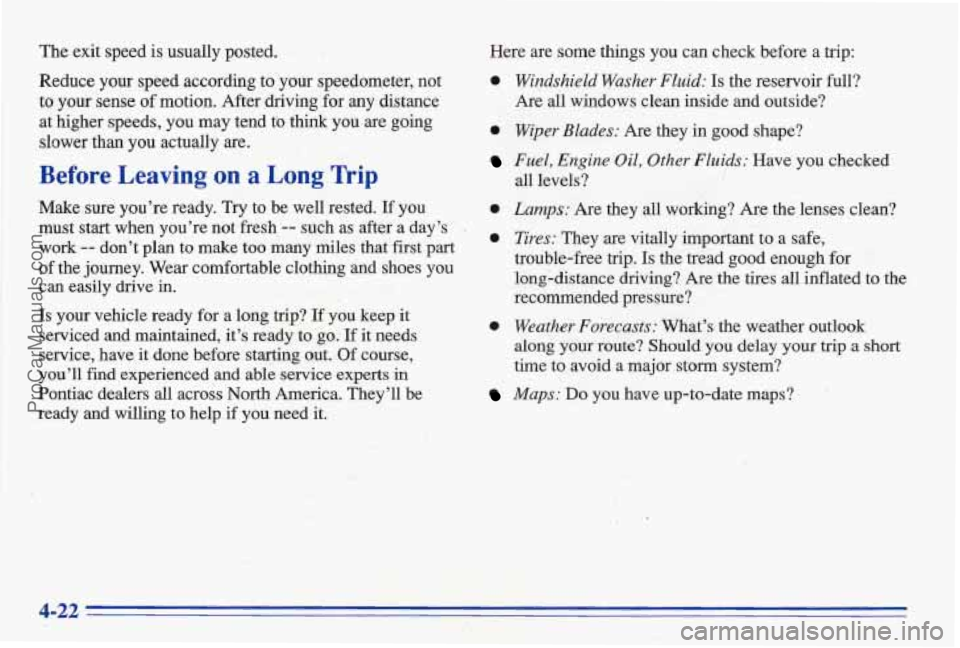
The exit speed is usually posted.
Reduce your speed according to
your speedometer, not
to your sense of motion. After driving for any distance
at higher speeds, you may tend
to think you are going
slower than
you actually are.
Before Leaving on a Long Trip
Make sure you’re ready. Try to be well rested. If you
. must start when you’re not fresh -- such as after a day’s
work
-- don’t plan to make too many miles that first part
of the journey. We,ar comfortable clothing and
shoes you
can easily drive in.
Is your vehicle ready for a long trip? If you keep it
serviced and maintained, it’s ready to
go. If it needs
service, have it done before starting out.
Of course,
you’ll find experienced and able service experts in
Pontiac dealers all across North America. They’ll be
ready and willing to help,if you need
it.
Here are some things you can check before a trip:
0 Windshield Washer Fluid: Is the reservoir full?
Are all windows clean inside and outside?
0 Wiper Blades: Are they in good shape?
Fuel, Engine Oil, Other Fluids: Have you checked
all levels?
0 Lamps: Are they all working? Are the lenses dean?
0 Tires: They are vitally irnportmt to a safe,
trouble-free trip.
Is the tread good enough for
long-distance driving? Are the tires
all inflated to the
recommended pressure?
0 Weather Forecasts: What’s the weather outlook
along your route? Should you delay your trip a short
time to avoid a major storm system?
Maps: Do you have up-to-date maps?
ProCarManuals.com
Page 190 of 387
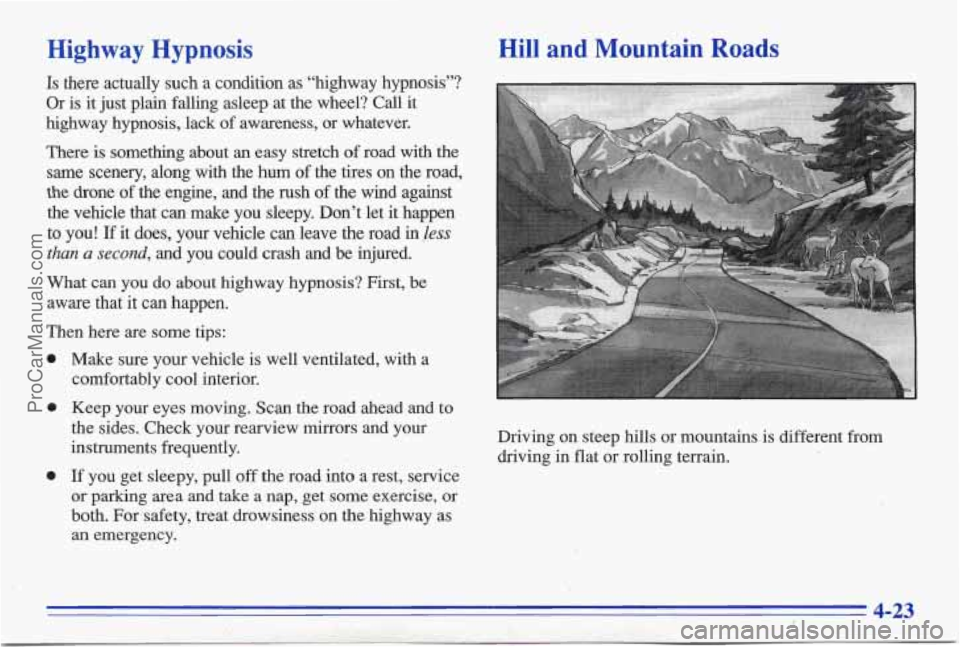
Highway Hypnosis
Is there actually such a condition as “highway hypnosis”?
Or is it just plain falling asleep at the wheel? Call it
highway hypnosis, lack of awareness, or whatever.
There
is something about an easy stretch of road with the
same scenery, along with the hum of the tires on the road,
the drone of the engine, and the rush of the wind against
the vehicle that can make you sleepy. Don’t let
it happen
to
you! If it does, your vehicle can leave the road h Zess
than a second, and you could crash and be injured.
What can you
do about highway hypnosis? First, be
aware that
it can happen.
Then here are some tips:
0
a
0
Make sure your vehicle is well ventilated, with a comfortably cool interior.
Keep your eyes moving.
Scan the road ahead and to
the sides. Check your rearview mirrors and your
instruments frequently.
If you get sleepy, pull off the road into a rest, service
or parking area
and take a nap, get some exercise, or
both. For safety, treat drowsiness on the highway as
an emergency.
Hill and Mountain Roads
Driving on steep hills or mountains is different from
driving in flat or ,rolling terrain.
ProCarManuals.com